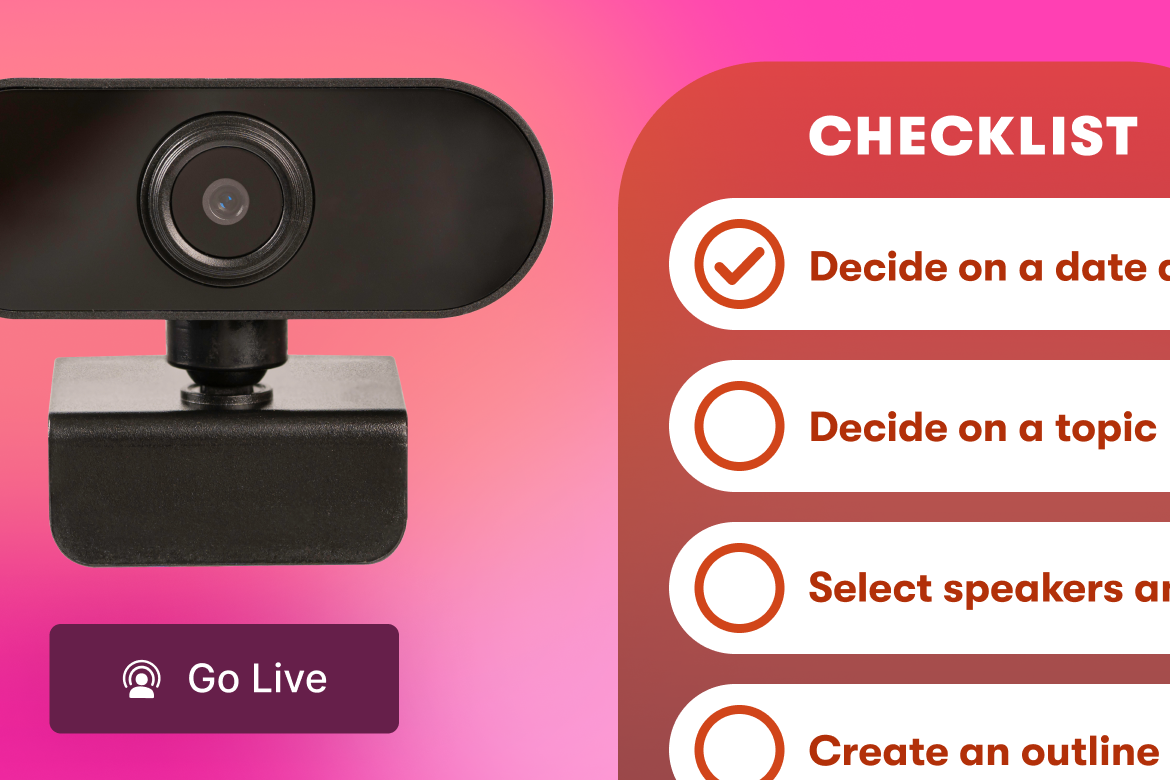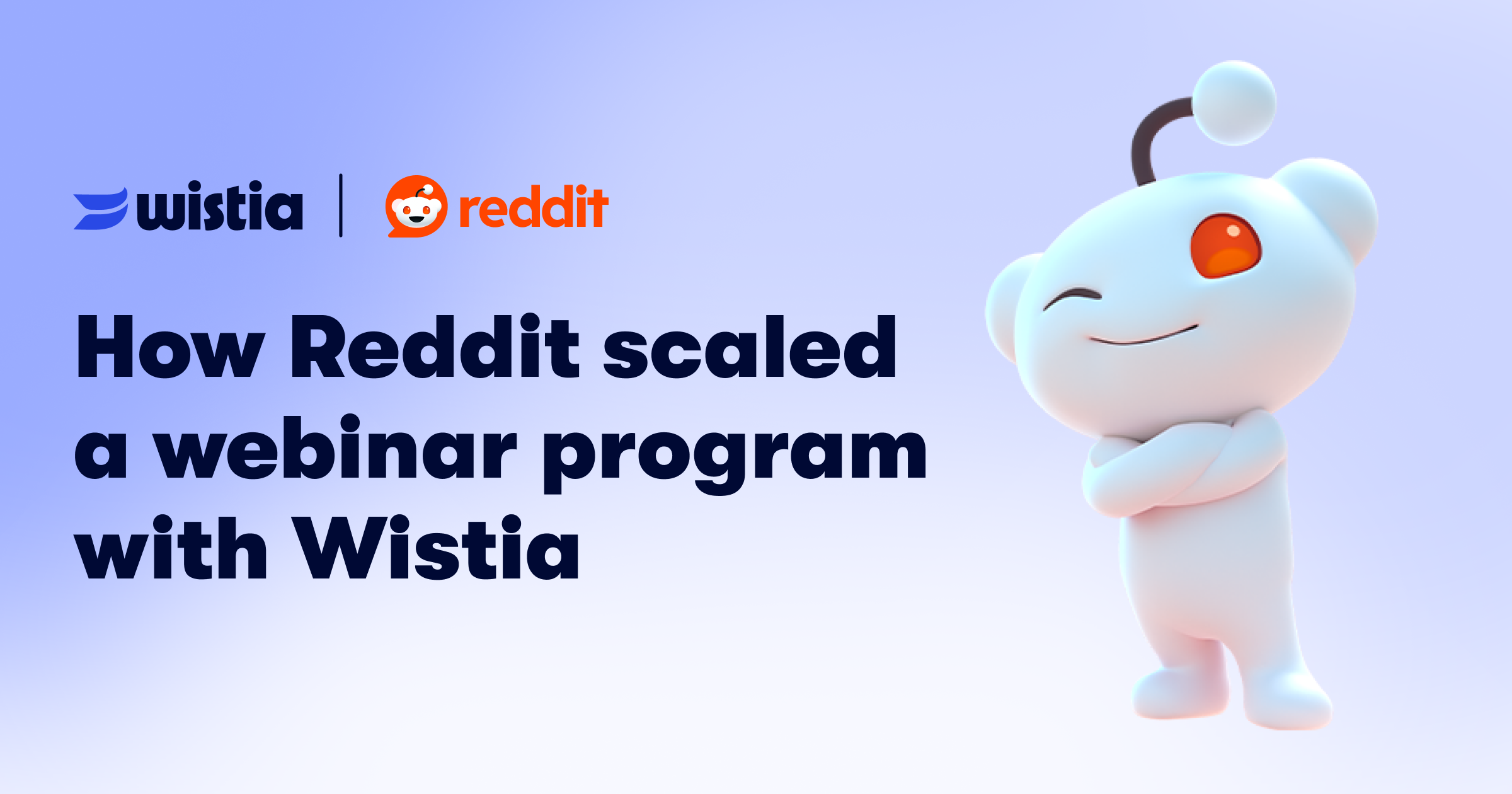Podcast Like a Pro: A Crash Course for Marketers
February 22, 2021
Topic tags
Whether you’re a podcasting pro or you’re just dipping your toes into the audio content waters, there’s no denying that podcasting has cemented itself as a key part of a well-rounded content strategy.
Did you know — podcast listeners spend an average of 6 hours and 37 minutes listening to podcasts every week. And, 63% of listeners tune into more podcasts now than they did just one year ago. There’s no denying the value of audio content and what it can bring to the table for brands.
But as a marketer, it can feel daunting to add yet another tactic to your arsenal. How do you even get started? What gear do you need? And how do you support show growth over time?
If these questions keep you up at night — it’s your lucky day. Adam Day, Lead Producer here at Wistia, has over ten years of experience producing podcasts.
In this recap, we’ll highlight Adam’s top tips for planning, producing, and promoting a podcast. This post is just the tip of the iceberg, so be sure to check out the full webinar for all the details!
Podcast Planning
When it comes to planning your podcast, you’re really trying to answer as many questions about the content as you can before you start working on it. That doesn’t mean things can’t and won’t change as you progress (spoiler alert, they probably will!), but proper planning is going to give you and your stakeholders the firmest footing before hitting record.
At Wistia, we think a lot about content as a product. With products, there is a development cycle, right? The same is true for content.
Stages of podcast planning
- Develop your idea
- Assemble your team
- Bring your idea to life with a script and branding
- Determine your KPIs
Develop your podcast idea
To get started, your podcast concept needs to align with your brand and your overall podcast goal. Run your ideas through the filter of your brand. Ask yourself, “does this make sense for our brand to talk about?”
Also, consider your audience. Who is your target listener? What are they like? What type of content do they crave? And how does your idea align with their needs and wants?
Once you have a solid idea that aligns with your brand and audience, put your idea on paper. In the production world, this is called a “treatment.” This can be pretty free form, but it should give anyone (even a complete stranger) a clear idea of exactly what your show is about and what it will feel like. If you’re struggling with putting your idea on paper, start with a show positioning statement first.
Pick a format that’s a good fit for your concept and easy to scale
Another aspect of your show to document in your treatment is your podcast’s format.
Format gives your podcast structure. It’s the backbone of your show and should drive other creative decisions related to podcast content. If you don’t know what format would be a good fit for your idea, look at shows you like and listen to for inspiration. And remember, you can play around with the format. Just because you have an interview-style show doesn’t mean you can’t add in specific segments or other elements to mix things up. Play around with your format and find a template that works best for your concept.
Consistency is key for setting your cadence
The next thing you’ll want to do is nail down your show cadence. This is often one of the most popular questions we get about podcasting — how often should we release new episodes. Unfortunately, there’s not a cut-and-dry answer here. It really does depend on your resources and goals.
The biggest thing to note about cadence is that it’s a commitment, and it can have significant implications for your business and how you operate. So, what are you willing to commit to, and what are you capable of committing to?
Also consider your own behaviors with the type of show you’re creating — is this a bingeable piece of content like a really compelling juicy story about your industry? Is this an interview show where I check in a few times a month and pick my favorites of the weekly interviews they do?
Finally, keep in mind that people appreciate consistency. So, whatever you decide on for a show cadence, stick to it.
Building your podcast dream team
There’s no one way to build a podcast team, but there are a few essential roles you’ll need to fill. Here’s what you need to figure out:
- Who’s hosting? Every area of your organization could have something to offer your audience. What value are you trying to surface? Start there and work backward. (Hint: Your host doesn’t have to be CEO or even a member of the C-Suite)
- Who’s writing? You’re going to need someone to come up with the podcast script and source content for discussions.
- Who’s producing? Who is handling logistical things, coaching the host, and ensuring production and post-production are running smoothly?
- Who’s booking? Yep, you guessed it. If you’re running an interview-style podcast, you’re going to need someone in the group booking guests and running communications.
- Who’s engineering? Who is going to turn all of this audio content into a polished final product?
Keep in mind — this might all be one person. There are lots of solo podcasters out there doing amazing things. Don’t let this list intimidate you; it’s really just meant to highlight the work that goes into producing a full episode from start to finish. Use this as a starting point to build your own podcast process.
Bring your podcast to life
You’ve assembled your podcast avengers and have a firm concept to move forward with… now what? It’s time to bring your podcast to life! This stage involves scripting your first episode and building the brand for your show.
Script your first episode
You’ve reached a point where your idea is really developed and documented. You’ve got your team assembled. Now, let’s start to bring the show to life a bit more.
Your podcast script doesn’t have to be a word-for-word replica of exactly what you’ll say in your episode (though if that level of detail is helpful for your host, go for it!). Instead, start with a rough outline. Think through your intro and outro details — what kind of vibe do you want to set with music? Will you keep episodes organic, or will you pre-record a scripted intro and outro for each episode?
You can keep the outline high level, but you should get into the weeds on specific details, like the intro and outro, different segments, transitions between segments, etc.
Podcast art and branding
Of course, you can’t forget about show branding. It’s helpful to save this process until you have a minimal viable product to work with. From there, it’s beneficial to loop in your design team on the show’s inspiration, overall tone, treatment, and a sample episode. The podcast branding process should feel collaborative to really bring the vision to life.
The absolute minimum thing you need to brand your show is a square image — and it’s important that you get the size of this right because if your artwork isn’t the right size, it will be rejected from some podcast distribution platforms.
That said — your podcast is a new branch of your business’s brand! So, you can really go as big as you want with different promotional assets.
Determine how you’ll measure success
Don’t forget to determine your measure of success for your show in the planning stage! Like your treatment and your audience, this can really help you focus as you start producing and releasing episodes. Setting clear measures of success can also set up the levers for what you can experiment with.
Keep in mind — determining the “success” of a podcast can be hard. We’ve experienced this exact pain at Wistia. For us, we consider our podcast top-of-funnel content. We want our shows to boost not only awareness but build affinity for our brand. We want our show to not only attract new people but also keep them around.
At Wistia, we focus on three specific KPIs: subscriber growth, time spent with our brand, and episode-specific calls to action. That’s it. That’s how we gauge whether our podcast is working to support our brand and long-term company goals.
And while having quantitative KPIs is great — especially for selling the value of audio content to leadership — qualitative feedback is also important. We solicit direct feedback on our podcasts with an easy-to-remember email address. We invite folks to share what they enjoyed directly or simply keep the conversation going. This type of engagement is super valuable and a great way to tell if your content is resonating.
Whatever your measure of success, be sure to set the right expectations and commit to producing the show to meet those goals.
Podcast Production
Production is just about making things. So, at its most basic, production is really just about the podcast tools you need to make your content and the best way to use those tools to get the most out of your efforts. And then, how do you do this at scale?
With that said, folks are often curious about what we use or recommend here at Wistia, so I’m going to share three great setups for three different budgets. Each configuration includes four core pieces of podcast gear: microphone, audio interface, recording software, headphones.
Beginner podcast gear
- Microphone: Samson Q2U USB
- Headphones: You can use what you already have (Apple EarPods work great)
- Recording software: GarageBand or Audacity
Intermediate podcast gear
- Microphone: Shure Beta 58A
- USB audio interface: Focusrite Scarlett 2i2
- Headphones: AKG K240 Studio
- Recording software: LogicPro or ProTools
Advanced podcast gear
- Microphone: Shure SM7B
- USB audio interface: Apogee duet
- Headphones: AKG K240 Studio
- Acoustic treatment: Auralex panels
Tips for capturing great audio
Having the right podcasting gear is a great first step, but knowing how to use the equipment properly is just as important. Here are our top tips for improving your podcast sound quality no matter where you’re recording from.
- Pick a quiet spot to record
- Master microphone placement
- Set sound levels properly
- Make sure everyone wears headphones
- Record separate tracks for each guest
Post-production workflow
You’ve recorded your first podcast episode. Great! So what do you do with your audio files to get your show out into the world?
First things first, you’ll need to edit your show. If you’re strapped on resources or new to editing — don’t worry. Even beginner software like GarageBand makes it fairly easy to do some light editing, and you can easily find contract sound editors to help lighten the load.
From there, you’ll want to find a home for your audio content. This is your podcast host. We’re a little biased, and we think Wistia is a great option for hosting all of your audio and video content in one place. Whatever host you choose, you’ll want to make sure they can easily distribute your audio content to all of the major streaming platforms like Apple, Spotify, and more.
Podcast Promotion
You’ve made it this far into the process, and you’re almost to the finish line of launching your podcast. But before you release your audio content out into the world, you’re going to want to have a solid plan in place on how you’re going to get more eyes — er, ears — on your show. The adage, “build it and they will come,” sounds great, but attracting and retaining listeners is a bit more challenging than that.
Promotion is the wild west. You could get really creative and go crazy if you have the budget for it. For most brands, though, this probably isn’t the case. Here are a few specific tactics we use to promote podcasts at Wistia.
Make a trailer for your podcast
Think about movie trailers. They pull out the most compelling moments from a movie to pique interest and generate buzz. Folks walk away with a clear idea of what the movie is about and can’t wait to watch. This is exactly what your podcast trailer should do.
Once you have a few episodes in the bank, pull out the most interesting or funny moments and preview your show’s content to give folks a crash course on what they can expect and why they should subscribe.
Create promo assets for every channel
Podcasts are unique in that they lean heavily on audio, which doesn’t always translate well for promotion. This is where having a full brand for your podcast comes into play. Leverage your show’s brand elements in creative ways to build promo assets for your marketing channels.
Here’s an example of a promo assets we use for Talking Too Loud.
Ask guests to record a short selfie
An easy way to expand your audience? Have your guests record a short video talking about their experience on the show. This is a low-lift, high-return way to promote your guests and tease upcoming episodes.
Use audiograms to tease episode content
Of course, you can’t talk about podcast promotion without mentioning audiograms. An audiogram is an image that’s converted into a video by placing audio, a waveform, and transcriptions over the image. These particular assets work great for social media. We use Headliner for audiograms at Wistia.
Build an owned subscriber list by hosting content on your website
The most important part of podcast promotion? Giving your audio content a home on your website.
Yes, many folks listen to podcasts on their favorite streaming platform — Apple, Spotify, etc. And yes, you should absolutely distribute your podcast to these platforms.
However, relying on these third-parties makes it really hard to build a relationship with your listeners over time. It’s important to host these assets on your owned channels (your website) and build a direct line of communication with your raving fans. This can be achieved by having a dedicated webpage or Channel or by embedding podcast episodes onto blog pages.
—
There you have it — my podcasting crash course for marketers. This was a ton of information for one topic, but we wanted to give you a good foundation on how to plan, produce, and promote your show.
And remember — There are no hard and fast rules for producing a new podcast! Your end goal should be to produce high-quality content and build meaningful connections with your audience.






